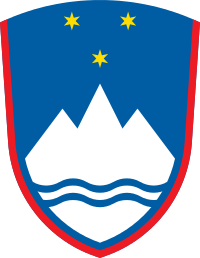Ljubljana Castle
.jpg)


.jpg)
Ljubljana Castle (Slovene: Ljubljanski grad) is a castle complex standing on Castle Hill above the downtown of Ljubljana, the capital of Slovenia. It is a key element of the Ljubljana skyline. Originally a Medieval fortress, probably built in the 11th century and rebuilt in the 12th century, it acquired its present outline with an almost complete overhaul in the 15th century, whereas the majority of the buildings date to the 16th and 17th centuries. At first a defense structure and since the first half of the 14th century the seat of the lords of Carniola, it was since the early 19th century used as a penitentiary, then in the first half of the 20th century as a residential complex and in the latest times as a tourist attraction and a major cultural venue.[1]
History
Ancient history
According to archeological surveys, the area of the present castle has been settled continuously since 1200 BC,[2] when the first settlements and later fortifications were built. The hill summit probably became a Roman army stronghold after fortifications were built in Illyrian and Celtic times.[3]
Middle Ages

The first Ljubljana Castle is believed to have been a wooden and stone fortification built in the 11th century.[1] The oldest written mention of Ljubljana Castle is inscribed on a parchment sheet Nomina defunctorum (names of the dead), which is kept by the Udine Cathedral Archive and most probably dates to the second half of 1161. It mentions the nobleman Rudolf of Tarcento, a lawyer of the Patriarchate of Aquileia, who had bestowed a canon with 20 farmsteads beside the castle of Ljubljana (castrum Leibach) to the Patriarchate. According to the historian Peter Štih's deduction, this happened between 1112 and 1125.[4]
Until 1144 the castle became property of the House of Sponheim.[4] In 1256, Ljubljana Castle was mentioned in a document as the most important castle of the rulers of Carniola (Latin: castrum capitalis).[5] In the late 1270, it was conquered by King Ottokar II of Bohemia. In 1278, after the defeat of Ottokar, it became property of Rudolph of Habsburg.
In the 15th century it was almost completely demolished and rebuilt with a complete wall and towers at the entrance, where a drawbridge was placed. A chapel was also built at that time. In the 16th and 17th centuries, other objects were gradually built. The castle's purpose was to defend the empire against Ottoman invasion as well as peasant revolt.[6]
Modern period
In the 17th and 18th centuries, the castle became an arsenal. In 1797 the town of Ljubljana and the castle were occupied for the first time by the French army, and again in 1809. In the period of the Illyrian Provinces, the castle was used as barracks and a military hospital. In 1815, back in the Austrian Empire, it became a prison, which it remained until 1895, with a hiatus between 1848 and 1868, resuming that function during World War II.[3][6] The castle's Viewing Tower dates to 1848; this was inhabited by a guard whose duty it was to fire cannons warning the city in case of fire or announcing important visitors or events.[3]
Because it was not a home of a ruler or another important noble person and because a fortification in the area was no longer required, the castle started to lose its importance. The maintenance costs were too high so the castle began to crumble. In the 19th century, the castle was redesigned partially as a prison and partially as a military stronghold, making it less popular among the citizens. Several famous people were jailed in the castle, including the Italian revolutionary Silvio Pellico, the Hungarian Prime Minister Lajos Batthyany and the Slovene author Ivan Cankar.
In 1905, the castle was bought by Municipality of Ljubljana for 60,200 Kronen, on the explicit wish of the mayor, Ivan Hribar, who planned to establish a city museum in it. The plan was however not carried out. Instead, the city decided to settle poor families into it. The residents stayed there until 1963, when preparations for renovation of the castle began. The remains of the fortifications on Castle Hill were reworked in the 1930s a promenade called Šance, designed by the Slovenian architect Jože Plečnik.
Contemporary history
Extensive renovation works commenced in the late 1960s; lasting more than 35 years. In the 1990s, the castle began to be used as a place for weddings and cultural events. In 1974, a monument by the sculptor Stojan Batič dedicated to the Slovene peasant revolts (especially to the Slovene peasant revolt of 1515 and the Croatian and Slovenian peasant revolt of 1573) was erected in the vicinity of the castle. The Ljubljana Castle funicular, a funicular railway to the top of Castle Hill, was built in 2006 and began service on 28 December 2006.[7]
References
- 1 2 Jakič, Ivan (1999). "Vsi slovenski gradovi: leksikon slovenske grajske zapuščine" [All Slovenian Castles: Encyclopedia of Slovenian Castle Heritage] (in Slovenian). Državna založba Slovenije. p. 191. ISBN 8634123251.
- ↑ Festival Ljubljana
- 1 2 3 "Ljubljanski grad / Ljubljana Castle". Archived from the original on 2 May 2008. Retrieved 2008-07-30.
- 1 2 Peter Štih (2010). Castrum Leibach: the first recorded mention of Ljubljana and the city's early history: facsimile with commentary and a history introduction (PDF). City Municipality of Ljubljana. ISBN 978-961-6449-36-6. COBISS 252833024
- ↑ Predovnik, Katarina (2011). "Ljubljanski grad" [Ljubljana Castle]. Castrum Bene (PDF). Ljubljana University Press, Faculty of Arts. pp. 65–67.
- 1 2 "City castle in Ljubljana". Retrieved 2008-07-30.
- ↑ "5 Years of the Funicular Railway to the Castle". City Municipality of Ljubljana. 28 December 2011.
External links
| Wikimedia Commons has media related to Ljubljana Castle. |
- Official site
- Surround photographies. Burger.si.
- Ljubljana Castle on Google Maps (map, photographs, street view)
Coordinates: 46°02′56″N 14°30′30″E / 46.04889°N 14.50833°E
